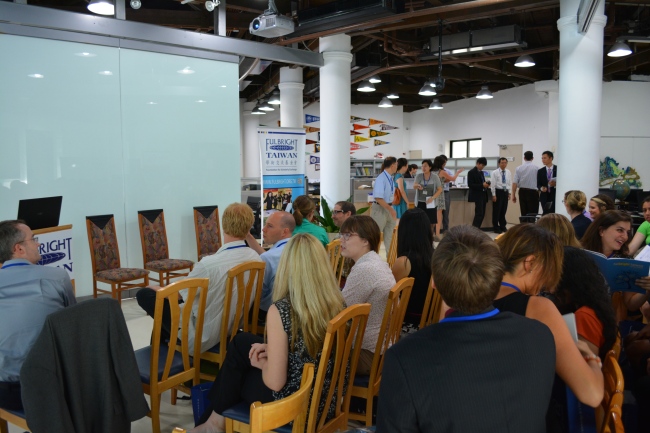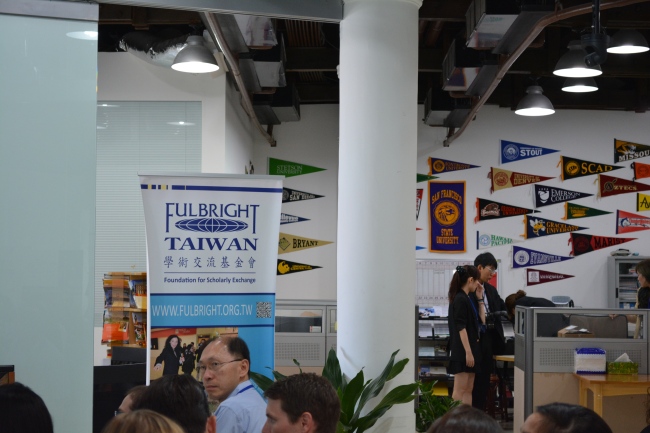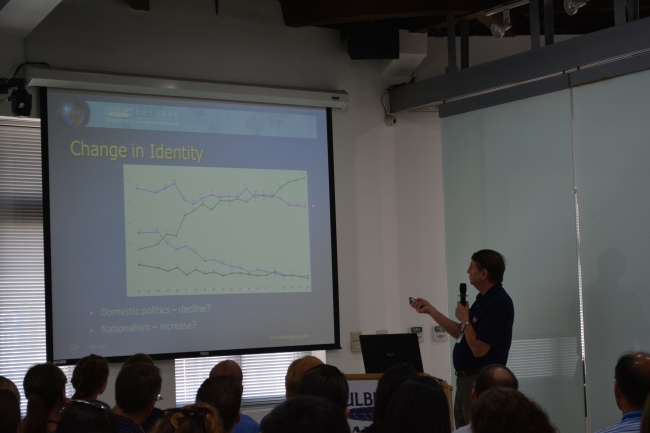Above: This is from Friday afternoon, but I just wanted to show you part of the interior of the office.
On Saturday at the Fulbright Taiwan office, we started off the day with research project introductions by the senior scholars and fellows. Every scholar and fellow had very interesting and unique academic and personal backgrounds, which made their research topics that much more fascinating. For example, there was a biochemical engineer working on creating cancer cell detectors, a former military attorney who had toured Iraq and Afghanistan looking at military law from the Qing Dynasty, a recent Naval Academy graduate researching security in the Asia pacific, and a Taiwanese-American dancer exploring the body as an instrument and ethnicity in dance performance among other scholars and fellows and their topics.
Above: Dr. Vocke pointing out the Japanese (Western appropriated) colonial style architecture of the FSE office building.
Above: A broken line graph showing the change in identity affiliation. The blue line shows the decline in the number of people who identify as Chinese and the green line shows the increase in the number of people who identify as Taiwanese over time.
After that Dr. Vocke gave a presentation on Taiwanese identity and a more detailed explanation of the political parties and the complexities involving security in the Asia Pacific, Taiwan’s economy, and Taiwan’s participation in international organizations. He also touched upon Taiwanese political history and gave us an introduction to The 228 Incident/Massacre committed by the KMT in 1947, since we were scheduled to visit the memorial in the afternoon.
For those of you who are not familiar with The 228 Incident/Massacre, this is what I learned:
-After the Japanese left in 1945 (after 50 years of colonial rule resulting from Japan’s victory of the Sino-Japanese war), the Chinese nationalist KMT (kuomintang) sent Chinese troops to Taiwan or temporary military occupation. This was called ‘retrocession.’
-The KMT did not think that Taiwanese were fit to govern themselves because they didn’t speak the national language/Mandarin.
-Because Taiwanese people at the time spoke Japanese besides Taiwanese (tai-yu), the KMT considered them to be siding with Japan. This was made worse by the fact that Japan invaded China.
-Corruption was rampant in the KMT government (political and economic monopoly), and the Taiwanese people began to demand reform and fair trials for corrupt police officers that made daily life difficult.
-Protests took place on Feb. 28, 1947, and military police opened fire on to the crowds outside of Provincial Executive Office.
-The governor of Taiwan at the time set up a committee to investigate the bloodshed, but instead called for military backup from Mainland China. Troops arrived on March 8th.
-Taiwanese social elites as well as those who participated in riots were arrested and executed by the KMT military forces.
-A period of martial law, called the White Terror, takes place for the next 38 years (’49-‘87) under Chiang Kai-shek ‘s KMT after the party’s exile from Mainland China.
We were told that even though fear about discussing 228 and the White Terror has decreased, people still don’t really talk about the Incident/Massacre (KMT is the current ruling party). However, it’s important for us as visitors to be aware of traumatic events such as this in order to begin to understand why people and things are the way they are today.
This is a picture of a letter in Japanese written by one of the martyrs in the 228 Memorial Museum. My next blog post will be about this.







